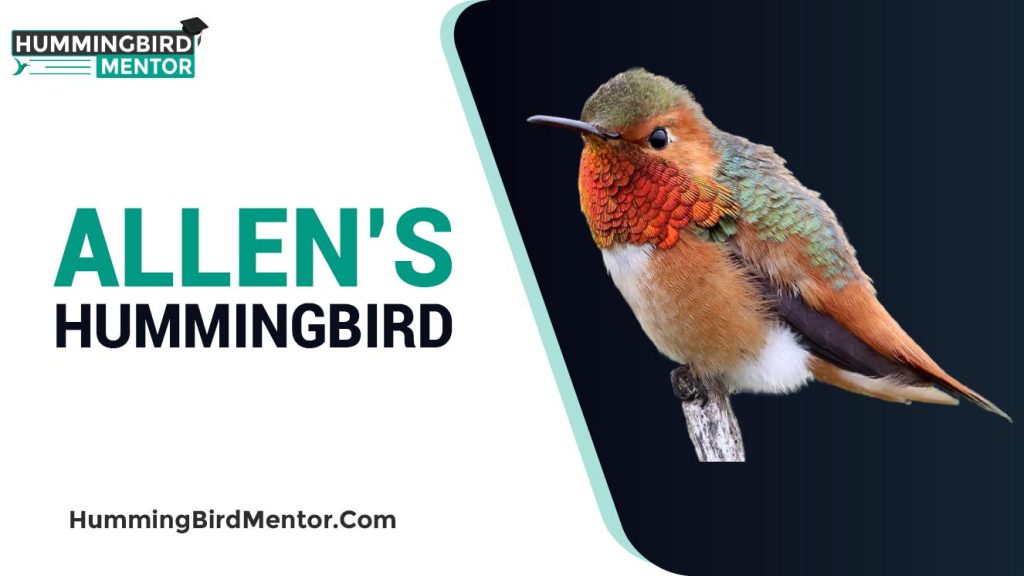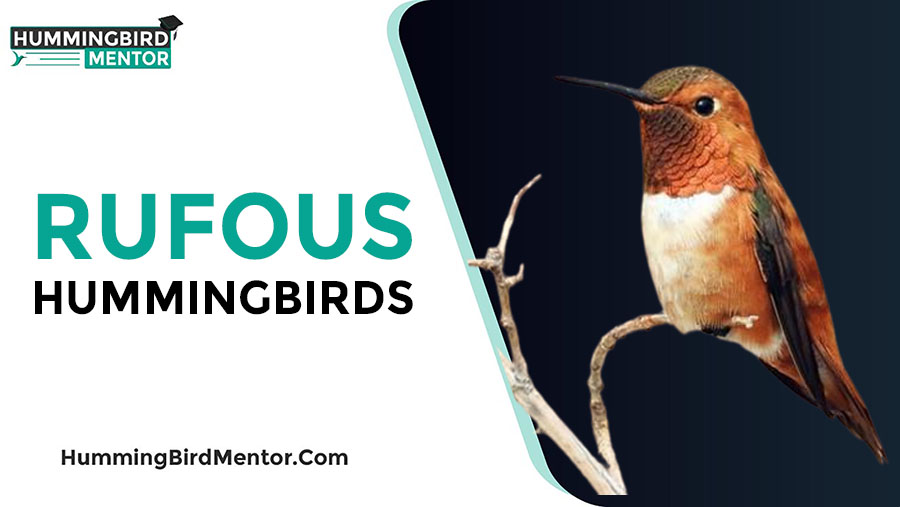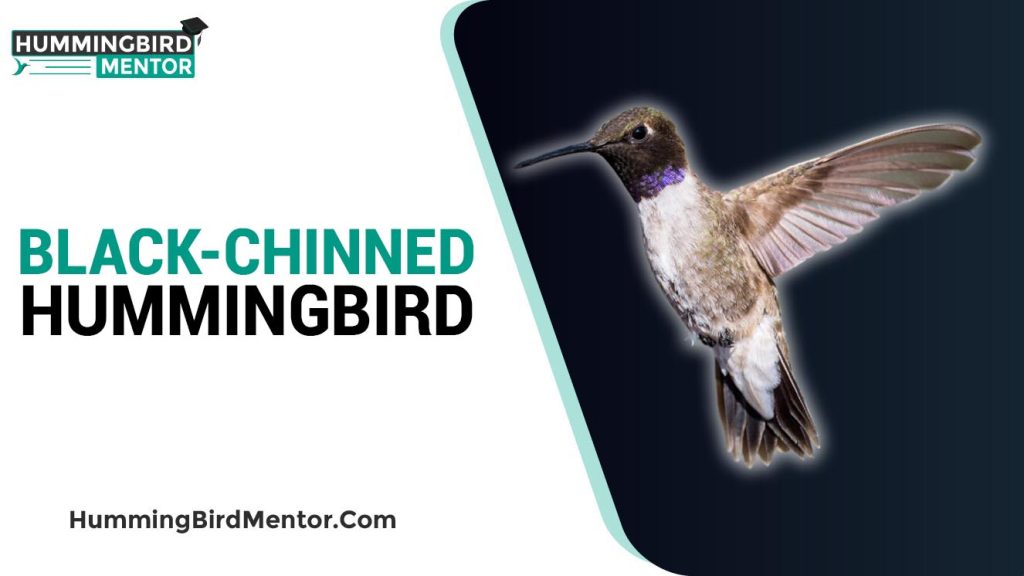The Ruby-throated hummingbird is one of the most common species of hummingbirds in North America. They spend their winter in Central America, Mexico, and Florida and move to Canada and some other parts of Eastern North America during summer for breeding. Ruby-throated hummingbirds are very quick and known for their squeaky chirps. Their bright red throat is just like the glittering jewel in the full sun. You can attract them into your garden with flowers and nectar feeders, just like the other hummingbird species. This species of hummingbird is common in suburbs and towns.

The female Ruby-throated hummingbirds are usually larger than the male Ruby-throated hummingbirds. They are aggressive towards the other hummingbirds and known for defending their territories. Their highest metabolic rate and the heartbeat of 1260 beats per minute are also unique compared to any animal. They consume more than 10 times oxygen per gram of muscle during their flight as compared to humans. Let’s know more about the Ruby-throated hummingbirds.
Scientific Name
The scientific name of the Ruby-throated hummingbird is Archilochus Colubris.
Conservation
The Ruby-throated hummingbird is one of those species of hummingbirds whose population is increasing day by day. Their population increased steadily from 1966 to 2019. The oldest known Ruby-throated Hummingbird was 9 years and 2 months. The females usually have more age with an average of 7 years as compared to males with an average of 5 years of age.
Size and Shape
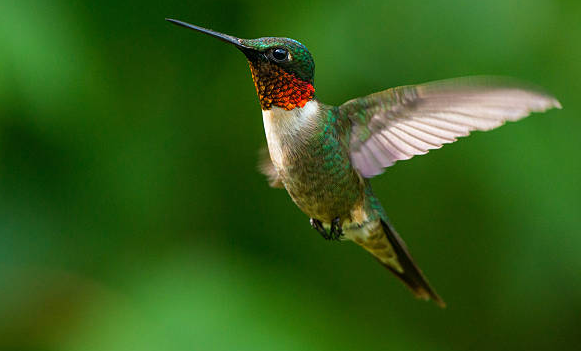
The Ruby-throated hummingbird is a small hummingbird, which can be 7 to 9cm long with 8 to 11cm wings span. The males usually have an average weight of 3.4 grams as compared to the female Ruby-throated hummingbirds, which can reach up to 3.8 grams. They have a long, straight, and slender bill of 2cm. Their wings never reach their tail when they are sitting. So, we can say that they almost have the same size as the black-chinned hummingbird.
Color pattern
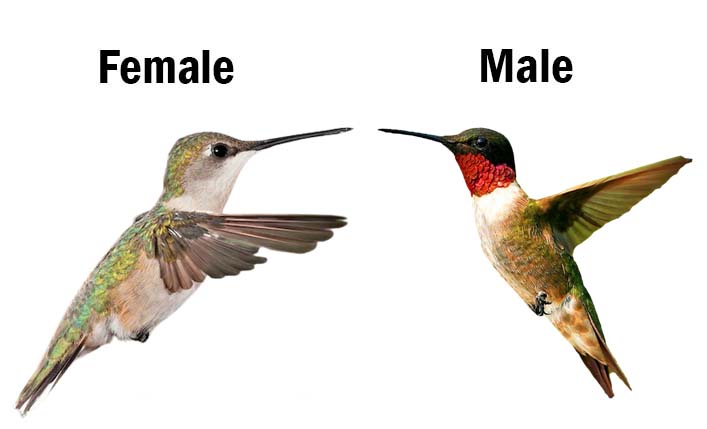
The Ruby-throated hummingbirds mostly have golden-green color. They have golden-green on their back and crown and gray-white on the underparts. The iridescent-red throat of the male Ruby-throated hummingbirds is very visible in the good light. The female Ruby-throated hummingbirds are banded in green, black, and white with white throats. You can also distinguish the male Ruby-throated hummingbirds from females due to their heavier throat markings.
Behavior
The Ruby-throated hummingbirds like to move straight and fast, but sometimes they also hover around the feeders to get the nectar and can adjust their positions accordingly. The tube-shaped nectar flowers are their favorite flowers, and they defend their food sources against the other hummingbirds. They also like to get tiny insects from air or from spider webs to fulfill their protein needs. You can locate them on the feeders and flowers as they like to get the nectar throughout the day to survive the colder nights by going into the torpor state.
Habitat
The Ruby-throated hummingbird is a migratory bird that spends its life in the different parts of Central America, Mexico, Florida, and Canada. Mostly they spend their breeding season in Eastern United States, South-central, and Southeastern Canada. They build their nests in pine forests at the forest’s edges, orchards, and gardens. They prefer the protected locations in the shrubs, as they have the longest breeding range as compared to all the other species of hummingbirds. The female Ruby-throated hummingbirds need these nests throughout their breeding season. So, you can locate their nests in the open woodlands, forest edges, meadows, grasslands, parks, gardens, and backyards.
Food
Red and the orange tubular nectar flowers are the favorite flowers of the Ruby-throated hummingbirds, which include the trumpet creeper, cardinal flower, honeysuckle, jewelweed, buckeye, bee-balm, and red morning glory. They also like to pick the insects from air and spider webs, which include mosquitoes, gnats, fruit flies, and small bees. Sometimes they also like to pick the cater pills and aphids from the leaves. You can also offer them the artificial nectar in hummingbird feeders. Take four parts of water and one part of sugar and mix it well before providing it to hummingbirds.
Nesting
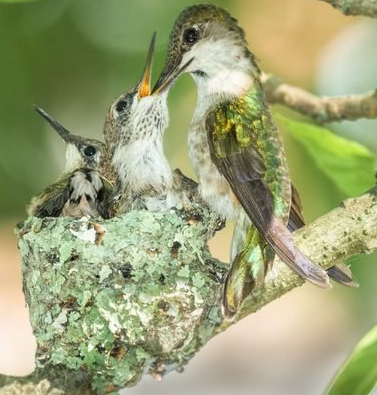 The Ruby-throated hummingbirds build the nests for their longest breeding season. Their nests are usually slender or on the tree branches such as oak, hornbeam, birch, poplar, or hackberry. Rarely, their nests are also seen on chain loops, wire, and extension cords. They built their thimble-sized nests on the branches. They use their neck and chest to perfectly shape the nests. Their nest is usually built-in 6 to 10 days and has 2 inches diameter with 1 inches depth. The female laid 1 to 3 eggs, which are very tiny, white, and weighted only half a gram. The incubation period of the eggs is 12 to 14 days, with the nesting period of 18 to 22 days.
The Ruby-throated hummingbirds build the nests for their longest breeding season. Their nests are usually slender or on the tree branches such as oak, hornbeam, birch, poplar, or hackberry. Rarely, their nests are also seen on chain loops, wire, and extension cords. They built their thimble-sized nests on the branches. They use their neck and chest to perfectly shape the nests. Their nest is usually built-in 6 to 10 days and has 2 inches diameter with 1 inches depth. The female laid 1 to 3 eggs, which are very tiny, white, and weighted only half a gram. The incubation period of the eggs is 12 to 14 days, with the nesting period of 18 to 22 days.
Migration
The Ruby-throated hummingbirds are migratory birds and can be located in the different parts of the United States, Mexico, and Canada. They fly nonstop over the Gulf of Mexico, which can be approximately about 500 miles. Usually, they start their fall migration as early as July and move to North America till mid-November. They start their spring migration in January and arrive at their breeding grounds between the end of February and early April. Some of the Ruby-throated hummingbirds travel to South to Central Mexico, west Panama, or Caribbean islands during their migration.
Songs and Calls
The male Ruby-throated hummingbirds are known for making the constant monotonous chips just at daybreak. Sometimes a common chee-dit call is also exchanged between the individuals. Both sexes also make the quiet humming sound with their wings, which are louder and have a high pitch in males.
Backyard Tips to attract Ruby-throated hummingbirds
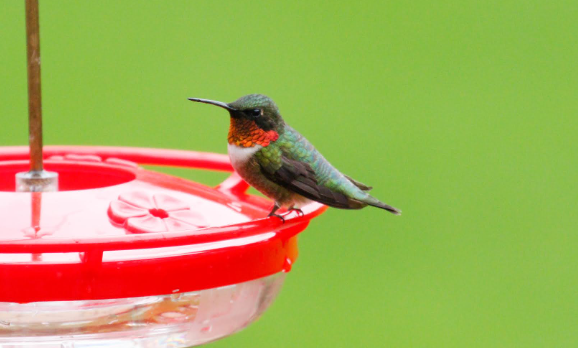
Like the other hummingbird species, you can attract the Ruby-throated hummingbirds in your garden by putting out the hummingbird feeders or planting their favorite tubular nectar flowers. You can make the sugar water mixture at your home by taking the four parts of water and one part of sugar. Remember to check the nectar regularly, especially during hot summer. The old moldy nectar can be poisonous to birds. The feeder location also matters a lot as some predators are also there to catch the visiting hummingbirds.
Cool Facts about Ruby-throated hummingbirds
The Ruby-throated hummingbirds are one of the most commonly found hummingbirds as compared to all the hummingbird species. Below are some of the cool facts about this special hummingbird species.
- The Ruby-throated hummingbirds can move their wings very fast. Their wing’s speed is approximately about 55 per second, which increases to 75 times per second when they are moving forward.
- Their legs are very short, which prevents them from walking and hopping. But short legs also help them in shuffling during perching.
- These are the only breeding hummingbirds in eastern North America from more than 330 hummingbird species.
- Usually, they make their nests in the forest edges, but they also like human habitation. You can often locate their nests on the loops of wire, chain, and extension cords.
- The red and orange color tubular flowers are their favorite. They can easily locate the different colors due to their good color vision and ultraviolet spectrum.
- Male and female Ruby-throated hummingbirds don’t stick around long. After a few days of mating, the males keep their own way and start their migration in August.
- The oldest Ruby-throated hummingbird was recaptured during the banding operation in 2014, which was 9 years and 2 months old at that time.
What is so special about the Ruby-throated hummingbirds?
The fast-moving speed of the Ruby-throated hummingbirds is very special and extraordinary as compared to other birds. These small jewels are capable of beating their small wings 55 times per second. You can hear their wing beating sound, which is also known as a humming sound.
How can we distinguish the male and female Ruby-throated hummingbirds?
The main difference is the red throat of the males as compared to the white throat of the females. On some rare occasions, females also have some red feathers on their throats. Moreover, you can also distinguish them from their tail feathers. The males usually have pointed tailed feathers as compared to the female’s rounded tailed feathers.
Do all the Ruby-throated hummingbirds migrate?
Hummingbirds are medium to full migrants that migrate to different parts of Eastern North America, Mexico, and Canada. Normally, they spend their winter in Central America by flying through the Gulf of Mexico.
What is the life span of a Ruby-throated hummingbird?
A Ruby-throated hummingbird can live up to 5 years. Most individuals can’t survive in the first year. But if somehow they survive for 1 year, their approximate age can be anywhere between 3 to 5 years.
How long can a Ruby-throated hummingbird maintain their torpor state?
The Ruby-throated hummingbirds can maintain their torpor state from 5 to 10 years. It’s found that the individuals who maintain their torpor state for longer have lower body mass loss as compared to the other individuals.
What time of the year does the female Ruby-throated hummingbird lay their eggs?
The female Ruby-throated hummingbird lay their eggs between March and July. Mid-May is the height of their breeding season when the females lay 1 to 3 eggs.
Conclusion
The Ruby-throated hummingbirds are the common hummingbirds whose population has been increasing day by day since 1966. These little jewels are known for their fast-moving speed and wing flapping speed as compared to the other hummingbird species. You can locate the Ruby-throated hummingbirds in the different parts of Eastern North America, Mexico, and Canada. They travel the different parts of these areas during their migration. The red throat is one of the prominent features of the male Ruby-throated hummingbirds.
